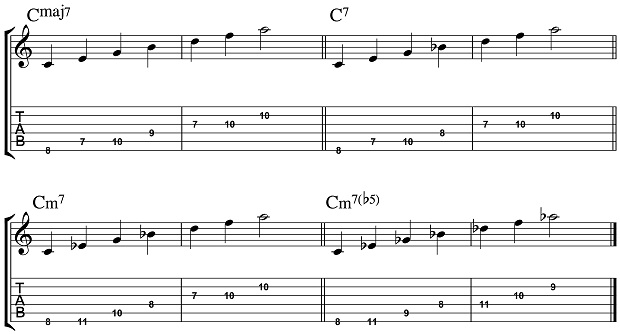How to Solo with Extended Jazz Guitar Arpeggios
Learn arpeggios up to the 13th for each of the four “basic” chords and how to apply this concept to major and minor key progressions.

When learning how to play jazz guitar, one of the first things we often explore in the practice room is outlining chord changes using arpeggios. Since arpeggios use only the notes in each chord, 1-3-5-7, they are great melodic devices to use when looking to dig into the chords you are soloing over, and bring out the exact sound of each change in the progression.
While learning four-note arpeggios is a must-have skill for any jazz guitarist, there is a further step you can take in your arpeggio workout that will extend these arpeggios to seven notes, bringing more “color tones” into your lines, as well as opening up the neck as you bring three new notes into the four-note arpeggio shapes you already know.
In this lesson, we’ll be looking at how you can learn arpeggios up to the 13th for each of the four “basic” chords, how to apply this concept to major and minor key progressions and how to work out these shapes in the practice room. If you like this concept, you can explore it further by checking out “Extended Jazz Guitar Arpeggios: Combining 4 and 3 Note Common Shapes.”
Four Basic Arpeggios to the 13th
The first thing to check out when delving into arpeggios up to the 13th is the four “basic” jazz chord types and their relative arpeggios. These chord types are maj7, 7, m7 and m7b5. You can, of course, explore other arpeggios, which we will do in the other examples below, but if you’re new to this concept or to jazz guitar in general, having a strong understanding of these four chords is an essential tool to have under your belt.
Notice how each arpeggio can be divided into two smaller melodic items, a four-note arpeggio (shown in bar 1 of each example) and a triad (shown in bar 2 of each example). I like to think about arpeggios up to the 13th in this manner, a four-note arpeggio plus a triad, as I find it helps when memorizing these shapes as well as allows me to mix in triad licks I already know when improvising with these 7-note arpeggios.
When you look at each of the four basic chord types, the maj7, 7 and m7 all have a minor triad starting from the 9th of each chord, while the m7b5 has a major triad starting from the b9 of the chord.
When working through these arpeggios in the practice room, try and see each arpeggio as a whole, a seven-note shape, but also try and break it up into a four-note arpeggio and a three-note triad, as this can add extra layers of melodic development and texture to your lines when bringing these shapes into your solos. I've written out the arpeggios for the four basic chord types below starting with a sixth-string root, but when you work these shapes out in the practice room, make sure to take them to the fifth string as well, and explore any alternate fingerings that you can come up with that help you bring these arpeggios around the neck in your practice routine.

Major ii V I VI with Arpeggios to 13th
Besides learning arpeggios up to the 13th for the four basic chord types, you can also use these shapes to practice chord changes. In the following example I wrote out the arpeggios up to the 13th for a ii-V-I-VI progression in the key of C major. To spice things up a bit, I added a #11 to the G7 and Cmaj7 chords in bars 2 and 3, which when you break it down to a four-note arpeggio plus a triad, produces a major triad this time from the 9th of both chords. I also used a b9b13 sound over the A7 in bar 4, which is a 13th arpeggio shape I really like to use in this context.
Here, there is a major triad starting on the b9 of the A7 chord, which produces the intervals b9-11-b13, giving you a nice altered quality that you would then resolve back to the Dm7 as you practice vamping over this progression.

Minor Key ii-V’s with Arpeggios to 13th
You can also apply these seven-note arpeggios to minor key progressions, as in the example below. Here, I used the same altered shape from the previous example, only this time over the V7, G7, chord, as well as spiced things up by bringing a mMaj7 sound to the tonic minor chord in bar 3. Soloing over minor key progressions can often be trickier than their major key counterparts, but by knowing the arpeggios up to the 13th for each chord you are blowing over, it will allow you to dig deep into the changes and outline each chord as you work your way through any minor vamp or tune you are jamming on.

Practice Tips
Once you’ve checked out these arpeggios as written in the examples above, try practicing the following exercises to help you bring them around the neck, expand them into all 12 keys and learn to improvise with this concept over vamps and tunes. All of these exercises can be applied to the four basic chord types alone, as well as to the ii-V-I progressions in both major and minor keys.
• Play each arpeggio ascending in 12 keys
• Play each arpeggio descending in 12 keys
• Alternate ascending and descending arpeggios in 12 keys
• Alternate descending and ascending arpeggios in 12 keys
• Improvise over a one chord vamp, or ii-V-I vamp, in 12 keys and improvise using only the 13th arpeggio for each chord you are soloing over.
Do you have a favorite way to practice extended arpeggios to the 13th? If so, share it in the comments section below.
Matt Warnock is the owner of mattwarnockguitar.com, a free website that provides hundreds of lessons and resources designed to help guitarists of all experience levels meet their practice and performance goals. Matt lives in the UK, where he is a senior lecturer at the Leeds College of Music and an examiner for the London College of Music (Registry of Guitar Tutors).
Get The Pick Newsletter
All the latest guitar news, interviews, lessons, reviews, deals and more, direct to your inbox!
Matt Warnock is the owner of mattwarnockguitar.com, a free website that provides hundreds of lessons and resources designed to help guitarists of all experience levels meet their practice and performance goals. Matt lives in the UK, where he teaches Skype guitar students all over the world, and is an examiner for the London College of Music (Registry of Guitar Tutors).









![Joe Bonamassa [left] wears a deep blue suit and polka-dotted shirt and plays his green refin Strat; the late Irish blues legend Rory Gallagher [right] screams and inflicts some punishment on his heavily worn number one Stratocaster.](https://cdn.mos.cms.futurecdn.net/cw28h7UBcTVfTLs7p7eiLe.jpg)
